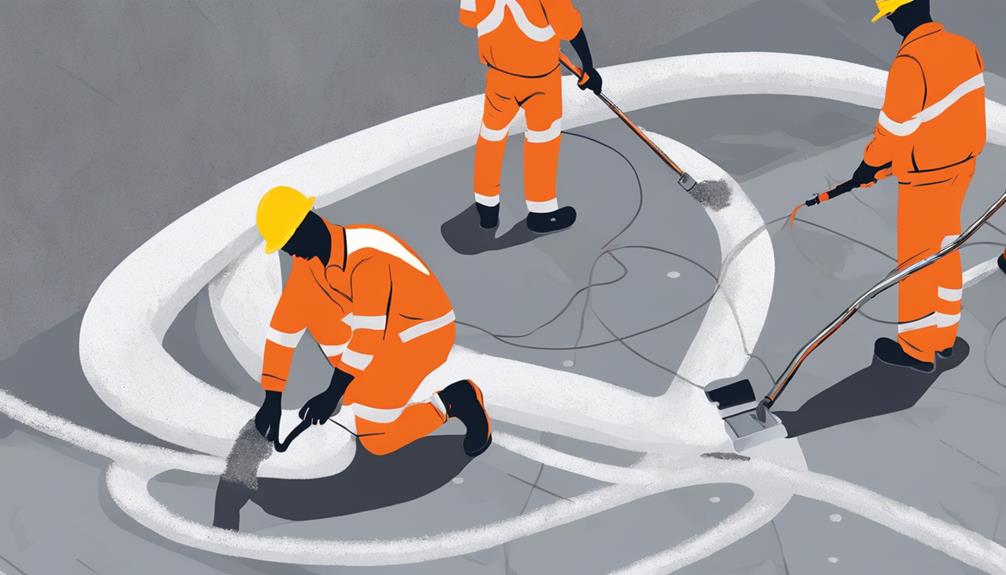The process of creating ice hockey rinks involves a meticulous series of steps that ultimately result in the pristine and glistening surface where exhilarating matches take place. From the initial planning and site preparation to the precise installation of dashers and boards, each stage contributes to the functionality and safety of the rink.
However, it is the intricate construction of the ice pad and the innovative cooling system that truly set the stage for the game to unfold. As we delve into the fascinating details of this elaborate process, a deeper appreciation for the craftsmanship and engineering behind ice hockey rinks emerges.
Planning and Site Preparation
In the initial phase of constructing ice hockey rinks, meticulous planning and thorough site preparation are essential to ensure a well-executed and safe facility. Site grading plays a crucial role in creating a level surface that is vital for proper ice formation and player safety. Careful attention is given to the slope of the rink to facilitate proper drainage and prevent water accumulation.
Additionally, equipment placement is strategically planned to optimize the functionality and efficiency of the rink. Items such as the refrigeration system, boards, and player benches are positioned thoughtfully to enhance the overall playing experience and ensure smooth operations. By adhering to precise site grading and meticulous equipment placement protocols, a high-quality ice hockey rink can be successfully developed.
Installing the Dashers and Boards
Having completed the meticulous planning and site preparation for the construction of ice hockey rinks, the next critical step involves the precise installation of the dashers and boards to establish the boundaries and structural framework of the rink.
Dasher placement is crucial as it defines the perimeter of the playing surface and provides support for the boards. The dashers, typically made of fiberglass or metal, are installed around the rink's edges at a consistent height to contain the puck during gameplay.
Once the dashers are in place, the boards are installed onto them, creating a seamless barrier around the rink. Board installation requires precision to ensure stability and safety for players. Together, the dashers and boards form the essential infrastructure of the ice hockey rink.
Building the Ice Pad and Cooling System
The construction process for ice hockey rinks advances with the meticulous assembly of the ice pad and cooling system, fundamental components essential for maintaining the optimal playing surface temperature.
The ice pad's thickness is crucial, typically ranging from 1 to 1.5 inches, ensuring durability and strength.
The cooling system, with its high cooling capacity, is responsible for regulating the ice temperature. This system enables precise temperature control, crucial for achieving the desired surface smoothness essential for the players' performance.
Painting the Ice Surface
Ensuring meticulous precision in the application process, the painting of the ice surface plays a critical role in enhancing visibility and aesthetics while also serving functional purposes in ice hockey rinks.
- Ice Texture: The application of paint not only adds color but can also affect the texture of the ice, providing different levels of grip for players.
- Logo Placement: Strategically placing team logos and sponsor branding requires careful planning to ensure they are visible but do not interfere with game play.
- Color Coordination: Coordinating the colors of the lines, circles, and logos with the team's branding contributes to the overall professional look of the rink.
The precise execution of the painting process is essential for creating a professional and functional ice surface for hockey games.
Adding Finishing Touches and Maintenance
To complete the ice hockey rink construction process, meticulous attention to adding finishing touches and implementing a robust maintenance plan is crucial for ensuring the longevity and optimal functionality of the facility.
Ice resurfacing techniques play a vital role in maintaining a smooth and safe playing surface. Regular resurfacing helps eliminate imperfections, ensuring players have optimal conditions for skating and gameplay.
Lighting fixtures are another essential aspect of the finishing touches. Proper lighting not only enhances the visibility for players, officials, and spectators but also contributes to the overall ambiance of the rink.
In terms of maintenance, a scheduled regimen for ice resurfacing, checking and maintaining lighting fixtures, as well as monitoring the overall condition of the rink, is imperative to uphold safety standards and preserve the quality of the facility.
Frequently Asked Questions
How Do Ice Hockey Rinks Handle Melting Ice and Excess Water During Warm Weather Conditions?
In the heat of summer, ice hockey rinks combat melting ice and excess water through sophisticated drainage systems and meticulous maintenance. Climate control technologies and precise water management strategies ensure the rink remains frozen and ready for play.
What Materials Are Used to Create the Ice Surface and How Are They Maintained Throughout the Season?
In ice rink maintenance, materials like ice resurfacing machines are crucial for maintaining the ice surface. Ice thickness and temperature are monitored closely throughout the season to ensure optimal playing conditions for hockey games.
Are There Any Environmental Concerns or Regulations Regarding the Cooling Systems Used in Ice Hockey Rinks?
When considering ice hockey rinks, it is essential to address environmental impact concerns and adhere to regulations. Cooling systems in rinks must meet standards to minimize energy consumption and refrigerant emissions, ensuring sustainability.
How Often Do Ice Hockey Rinks Need to Be Resurfaced and What Equipment Is Used for This Process?
Ice hockey rinks require resurfacing every 45-60 minutes to maintain ice quality. Zambonis, equipped with a sharp blade and a water tank, are commonly used for this task. Regular resurfacing is crucial for optimal ice maintenance.
Are There Any Special Considerations or Adaptations Made for Outdoor Ice Hockey Rinks Compared to Indoor Rinks?
Outdoor challenges present unique considerations for ice hockey rinks compared to indoor ones. Factors like climate control, aesthetics, and spectator experience must be carefully addressed to ensure optimal playing conditions and audience enjoyment in outdoor settings.









